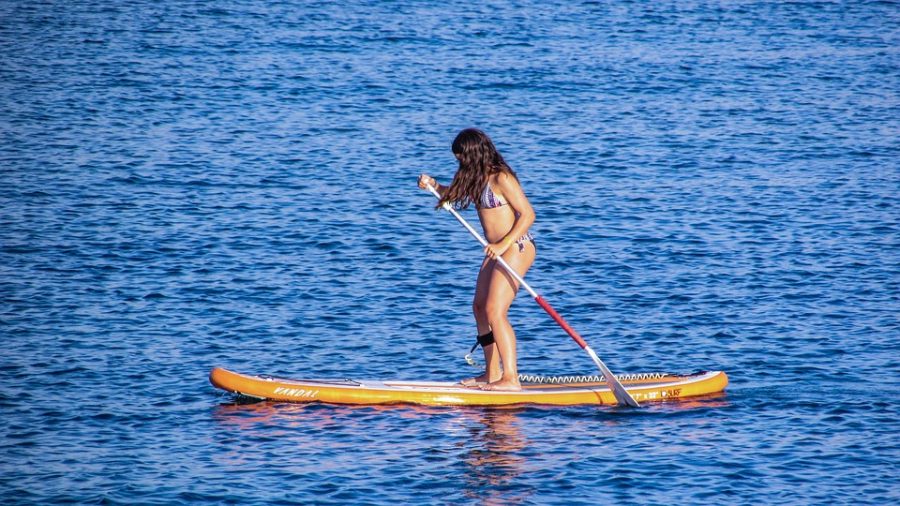
There is a much better and contemporary method for having fun in the outdoors and that is Stand Up Paddle Boarding as the ideal solution for your needs. Simply put this refers to the special offshoots of surfing that once originated from the surfing communities found all over the world.
Whereas conventional surfing typically involves a rider sitting until a wave come up the SUP boarders can stand on their boards and use a specially made paddle to propel themselves through the water.
It’s important to note that the paddles used in Stand up surfing are similar to but longer than the conventional canoe paddles. In most cases, the paddles are often constructed using fiberglass, carbon, and wood or perhaps with a flat blade on one end and connecting to the handle on the end by a long and smooth shaft. Besides that, the blades are often available with several shapes and features. Usually, the blade often has a banana-peel contour appearance that sometimes features a minute keel on the rear section of the blade
How to paddle board
The appropriate form for surfing requires the use of a paddle of the correct size and length. The prevalent and most recommended length is to ensure the paddle rests 4 to 7 inches above the surfer’s height for surfing and about ten inches above the riders height for racing activities.
The recommended method for holding the paddle is with the blade resting away from the user’s body. This, therefore, allows the paddler to move through the water faster. Here are some of the recommended gear for taking on the outdoors:
The stand-up paddle board – this is the key aspect of your unique paddle board regime. How you choose the board is determined by overall weight, skill and the desired use as well as the local weather conditions.
Paddle – it’s recommended for you to go for stand up paddles that have a special angle in the shaft for optimal efficiency when surfing. Therefore you should opt for a paddle that is 5 to 9 inches longer that you are.
SUP attire – if you are surfing in cold water conditions, it’s important that you protect yourself by wearing a dry suit or wet suit. However, in warm conditions, you might opt for a bathing suit, shorts or any other relevant attire for taking on the outdoors.
How to stand up on your SUP
If you are relatively new to the sport, it’s imperative that you start out by standing flat on calm waters that you are comfortable. An excellent suggestion for you at such a point would be to start out by kneeling rather than totally standing upwards. Here are some notable tips to kickstart your surfing regime
Position your body close to your board in water where you feel most comfortable, place the paddle along the main platform of your SUP and manipulate it as a hoisting mechanism. The position for placing your paddle is positioned on the side section of the SUP, and the blade is positioned on the water.
- Grip the SUP by the edges while you use one arm to grip the paddle for optimal balance
- Hoist your body onto the SUP on all fours just behind where the center of gravity of the board lies
- Navigate and paddle in relation to the weather conditions. Besides that, ensure you have the appropriate attire for taking on the outdoors.
- Maintain your hands on any side of the SUP to achieve optimal stability levels
When you feel ready, you can now proceed to rise up on the board slowly and ensure that you have sufficient balance beneath your feet.
SUP Stance
The SUP stance simply refers to the body position that is ideal when moving around the water with the board. Here are some recommendations:
Ensure that your feet are placed in a parallel manner and about 15 inches apart and set in a central position between the board and rails.
Try and maintain balance using your hips in combination with your upper body. More so, you should also maintain the ideal view above the water such that you are aware of incoming or oncoming objects such as swimmers or boats
SUP Stroke
Once you are competent enough to maintain your balance in the water, then its time to master the stroke:
If you are a right handed user, ensure that your right arm rests lower on the paddle than the left arm, and vice versa.
Position your arms facing downwards and twist your body as your continue paddling. It’s important to note that your strength levels are directly proportional to your size and weight.
- Press down on the paddle by using the top section of your hand
- To move in a straight direction, proceed to paddle on both sides of the paddle board
- It’s important to note that when you want to change sides, you should also alternate arms as well
There are various ways to navigate the paddle board:
Sidestroke – this involves paddling on one section to the point where the nose of the paddle board assumes the position that you need the most, Therefore, if you need to navigate right, you should paddle on the left and the same applies for vice versa as well.
Back paddle – this is an efficient method for turning or reversing the direction, and it often involves dragging the paddle backward or perhaps on any Section of the SUP.
Sweep stroke – you position the paddle facing the front section of the SUP and take powerful pulls away from the board and towards the rear section of the paddle board.
How to Get Back on a Paddleboard after Falling Off
Like any other sport, paddle boarding requires practice to acquire perfection in paddling especially in handling the paddleboard. However, regardless of whether you are a beginner or a professional in the sport, you must fall off your paddleboard at some point. In that case, it is not a matter of if but a matter of when so you need to be prepared. This article shows you how to get back on your paddleboard after falling off.
How to Get Back on a Paddleboard after Falling Off
1.Position Yourself Correctly
After falling off your paddleboard, do not panic but instead position yourself correctly to get back on your paddleboard.
Ensure that you are at the center of the board (where the handle is located) as this is the most balanced part of the paddleboard. Lugging on this part is sure to help you get back on your paddleboard successfully.
2.Use your Predominant Hand To Pull Yourself Onto The Paddleboard
When you acquire the best position, pulling yourself up is the next thing. Use your predominant hand to pull yourself onto the paddleboard and use the other hand to hold it in place. It is important to note that if you are left-handed, the best side to climb up your paddleboard is the right side while if you are right-handed, the best part to get back on your paddleboard is the left side.
When about to pull yourself back onto your paddleboard, ensure that your predominant hand goes across the board to its centerline. This offsets your weight equally on the rail that you intend to climb up. you can use other weight offsetting and board holding tips such as trying to reach out to the rail lying across your paddleboard then carefully pulling yourself up or you can hold on to the handle (if you have a wide board). Your other hand should help you keep the paddle in place while you pull yourself up.
3.Acquire a Comfortable Sitting Position
Once you have pulled yourself up to a position where the entire weight of your torso is on your paddleboard, swing your legs around the sides of the board and get yourself to a position where you can sit.
4.Stand Up Slowly
Here is where you need to be very careful. Begin by dropping the paddle across the board then slowly shift your weight forward and put your soles down. Stand up carefully and you will be back on your paddleboard successfully.
It is important to note that even the best fall off their paddleboards. It is therefore not a surprise when you as a beginner fall off more times than you can count. When it happens, never give up. Instead, insist on practicing until the day you perfect the art. Enjoy the process rather than taking it as a hard task. In no time, you will notice that you will have perfected the skill to the extent that you will be in a position to help others learn.
Alternative Way of Getting Back to your Paddleboard after Falling Off
If the above method does not work for you or seems a little bit complicated, you can try the alternative method below:
- Swim towards the back of your board
- Place yourself in a position where you are eye level with the tail and you can look directly at the paddleboard
- Choose a side that suits you and then grab the tail while pushing the board downwards so that your body comes out of the water while the tail submerges.
- Continue to push the board down until you can sit on its end.
- Slide carefully back onto your paddle board.
At one time, whether you are a beginner or an expert, you must fall off your paddleboard. However, it is more challenging for beginners to get back to their paddleboards as it is for experts. This calls for the perfection of skills that enhance efficient get bat to paddleboards by beginners.
How to Stand Up Paddle Surf
This is a great video to show you how to SUP surf, from safety tips to how to catch that wave and how to surf it.
The 3 challenges:
- Paddling into a wave
- Catching a wave
- Surfing a wave
About the author: Chris loves the outdoors and has developed a love of gadgets and inflatable toys, from kayaking and paddle boarding to relaxing in his hot tub at home. The founder of WhichInflatable and has been the editor for 7 years.
Which Inflatable is supported by its audience. When you purchase through links on our site, we may earn an affiliate commission.

